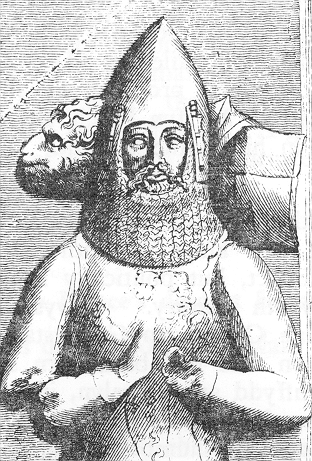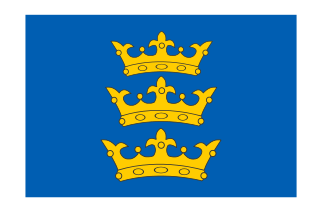
Rhys ap Gruffydd or ap Gruffudd was the ruler of the kingdom of Deheubarth in south Wales from 1155 to 1197. Today, he is commonly known as The Lord Rhys, in Welsh Yr Arglwydd Rhys, although this title may have not been used in his lifetime. He usually used the title "Proprietary Prince of Deheubarth" or "Prince of South Wales", but two documents have been discovered in which he uses the title "Prince of Wales" or "Prince of the Welsh". Rhys was one of the most successful and powerful Welsh princes, and, after the death of Owain Gwynedd of Gwynedd in 1170, the dominant power in Wales.
The Welsh Marches is an imprecisely defined area along the border between England and Wales in the United Kingdom. The precise meaning of the term has varied at different periods.

A marcher lord was a noble appointed by the king of England to guard the border between England and Wales.

The Lordship of Ireland, sometimes referred to retrospectively as Anglo-Norman Ireland, was the part of Ireland ruled by the King of England and controlled by loyal Anglo-Norman lords between 1177 and 1542. The lordship was created following the Anglo-Norman invasion of Ireland in 1169–1171. It was a papal fief, granted to the Plantagenet kings of England by the Holy See, via Laudabiliter. As the Lord of Ireland was also the King of England, he was represented locally by a governor, variously known as the Justiciar, Lieutenant, Lord Lieutenant or Lord Deputy.

The Anglo-Normans were the medieval ruling class in England following the Norman Conquest, and were primarily a combination of Normans, Frenchmen, Flemings, and Bretons who intermarried with the indigenous Anglo-Saxons and Celtic Britons. A small number of Normans had earlier befriended future Anglo-Saxon king of England, Edward the Confessor, during his exile in his mother's homeland of Normandy in northern France. When he returned to England, some of them went with him; as such, there were Normans already settled in England prior to the conquest. Edward's successor, Harold Godwinson, was defeated by Duke William the Conqueror of Normandy at the Battle of Hastings, leading to William's accession to the English throne.

The Kingdom of England was a sovereign state on the island of Great Britain from the early 10th century, when it emerged from various Anglo-Saxon kingdoms, until 1 May 1707, when it united with Scotland to form the Kingdom of Great Britain, which would later become the United Kingdom. The Kingdom of England was among the most powerful states in Europe during the medieval and early modern colonial periods.
Carew is a Welsh and Cornish habitation-type surname; it has also been used as a synonym for the Irish patronymic Ó Corráin. Carey can be a variant.
Diarmait Mac Murchada, was King of Leinster in Ireland from 1127 to 1171. In 1167, he was deposed by the High King of Ireland, Ruaidrí Ua Conchobair. To recover his kingdom, Mac Murchada solicited help from King Henry II of England. His issue unresolved, he gained the military support of the Richard de Clare, 2nd Earl of Pembroke, thus initiating the Anglo-Norman invasion of Ireland.
Richard de Clare, 2nd Earl of Pembroke, also Lord of Leinster and Justiciar of Ireland, was an Anglo-Norman nobleman notable for his leading role in the Anglo-Norman invasion of Ireland. Like his father, Richard is commonly known by his nickname, Strongbow.

Hiberno-Normans, or Norman Irish, refer to Irish families descended from Norman settlers who arrived during the Anglo-Norman invasion of Ireland in the 12th century, mainly from England and Wales. During the High Middle Ages and Late Middle Ages, the Hiberno-Normans constituted a feudal aristocracy and merchant oligarchy, known as the Lordship of Ireland. The Hiberno-Normans were also closely associated with the Gregorian Reform of the Catholic Church in Ireland and were responsible for the emergence of Hiberno-English.

Robert FitzStephen was a Cambro-Norman soldier, one of the leaders of the Norman invasion of Ireland, for which he was granted extensive lands in Ireland. He was a son of the famous Nest, daughter of Rhys ap Tewdwr, the last king of Deheubarth. His father was Nest's second husband, Stephen, Constable of Cardigan. Following the death of her first husband, Gerald de Windsor, her sons had married her to Stephen, her husband's constable for Cardigan. By Stephen, she had another son, possibly two; the eldest was Robert, and the younger may have been Hywel.

RaymondFitz William Fitz Gerald, nicknamed Le Gros, was a Cambro-Norman commander during the Norman invasion of Ireland. Raymond was among the first of a small band of Norman knights who landed on the South coast of Ireland before being reinforced by a larger force led by Richard de Clare, 2nd Earl of Pembroke. He was active consolidating Norman rule over Ireland before he retired to his estates in Waterford where he died in the late 12th century.

The history of Ireland from 1169–1536 covers the period from the arrival of the Cambro-Normans to the reign of Henry VIII of England, who made himself King of Ireland. After the Norman invasion of 1169–1171, Ireland was under an alternating level of control from Norman lords and the King of England. Previously, Ireland had seen intermittent warfare between provincial kingdoms over the position of High King. This situation was transformed by intervention in these conflicts by Norman mercenaries and later the English crown. After their successful conquest of England, the Normans turned their attention to Ireland. Ireland was made a lordship of the King of England and much of its land was seized by Norman barons. With time, Hiberno-Norman rule shrank to a territory known as the Pale, stretching from Dublin to Dundalk. The Hiberno-Norman lords elsewhere in the country became Gaelicised and integrated in Gaelic society.

The House of Clare was a prominent Anglo-Norman noble house that ruled the Earldoms of Pembroke, Hertford and Gloucester in England and Wales throughout its history, playing a prominent role in the Norman invasion of Ireland.

The Anglo-Norman invasion of Ireland took place during the late 12th century, when Anglo-Normans gradually conquered and acquired large swathes of land from the Irish, over which the kings of England then claimed sovereignty, all allegedly sanctioned by the papal bull Laudabiliter. At the time, Gaelic Ireland was made up of several kingdoms, with a High King claiming lordship over most of the other kings. The Anglo-Norman invasion was a watershed in Ireland's history, marking the beginning of more than 800 years of direct English and, later, British, conquest and colonialism in Ireland.

de Lacy is the surname of an old Norman family which originated from Lassy, Calvados. The family took part in the Norman Conquest of England and the later Norman invasion of Ireland. The name is first recorded for Hugh de Lacy (1020–1085). His sons, Walter and Ilbert, left Normandy and travelled to England with William the Conqueror. The awards of land by the Conqueror to the de Lacy sons led to two distinct branches of the family: the northern branch, centred on Blackburnshire and west Yorkshire was held by Ilbert's descendants; the southern branch of Marcher Lords, centred on Herefordshire and Shropshire, was held by Walter's descendants.

The Italo-Normans, or Siculo-Normans (Siculo-Normanni) when referring to Sicily and Southern Italy, are the Italian-born descendants of the first Norman conquerors to travel to Southern Italy in the first half of the eleventh century. While maintaining much of their distinctly Norman piety and customs of war, they were shaped by the diversity of Southern Italy, by the cultures and customs of the Greeks, Lombards, and Arabs in Sicily.

Walter de Lacy was lord of Meath in Ireland. He was also a substantial land owner in Weobley, Herefordshire, in Ludlow, Shropshire, in Ewyas Lacy in the Welsh Marches, and several lands in Normandy. He was the eldest son of Hugh de Lacy, a leading Cambro-Norman baron in the Norman invasion of Ireland, and Rohese of Monmouth.

The siege of Wexford took place in early May 1169 and was the first major clash of the Anglo-Norman invasion of Ireland. The town was besieged by a combined force of Normans under Robert Fitz-Stephen and soldiers loyal to Diarmait mac Murchadha. After being ousted as King of Leinster, Diarmait had recruited the Normans to help him regain control of Leinster and the semi-independent Norse-Gaelic seaport of Wexford. Although the attackers did not breach the town's walls, Wexford surrendered after almost two days and came under Norman control.

The conquest of Wales by Edward I took place between 1277 and 1283. It is sometimes referred to as the Edwardian conquest of Wales, to distinguish it from the earlier Norman conquest of Wales. In two campaigns, in 1277 and 1282–83, respectively, Edward I of England first greatly reduced the territory of Llywelyn ap Gruffudd, and then completely overran it, as well as the other remaining Welsh principalities.

















